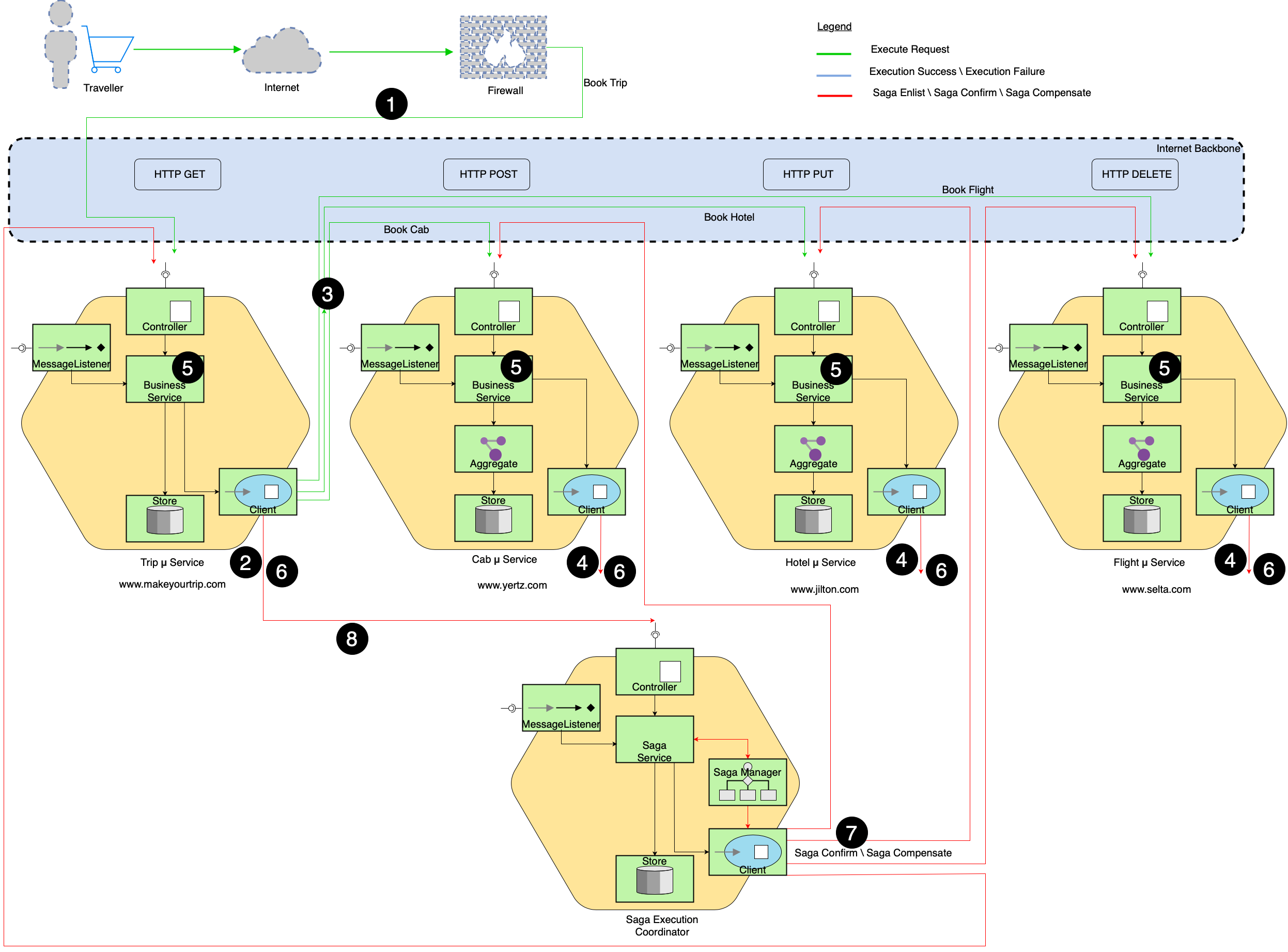Sagas are typically used for modeling long-lived transactions like those involved in workflows. It is not advisable to use two-phase transaction protocols to control long-lived transactions since the locking of resources for prolonged durations across trust boundaries is not practical, rather is not at all advisable. Sagas are similar to nested transactions. In a nested transaction, atomic transactions are embedded in other transactions. In sagas, each of these transactions has a corresponding compensating transaction. While a Saga proceeds with its steps, if any of the transactions in a saga fails, the compensating actions for each transaction that was successfully run previously will be invoked so as to nullify the effect of the previously successful transactions.
Modeling a Saga and setting up a Saga Infrastructure is rather straight forward in Local and simple deployments, however when we want to scale out in public cloud environments, and that too with multiple instances of the same type of microservice, there comes a new list of challenges. We will look at few of them in this discussion.
Setting the Context for Saga
We will not attempt to explain what a Saga is in more details here since it’s covered well in the DZone article titled “Distributed Sagas for Microservices.” The sample described there is an apt business case for our discussion, and we will use that in our explanation here. The scenario is that of doing a Travel booking. Many Travel agent booking systems provide this feature where they aggregate multiple kinds of travel inventories from different enterprises who actually own the inventory. It’s very unlikely that a single enterprise owns inventory for all these resources, but it’s highly likely that the end-user wants to book one or more of these resources in a single transaction because a confirmed hotel booking with a non-confirmed flight booking is not very useful for him!
In our case, The Travel agent enterprise refers to www.makeyourtrip.com. Travelers can come to this web site and reserve a complete travel package, which involves booking inventories of multiple types.
Let’s assume that makeyourtrip has got a partnership with 3 other enterprises for retrieving inventories, as follows:
- www.yertz.com - Can Rental Services
- www.jilton.com - Hotel Room Rental Services
- www.selta.com - Flight Booking Services
The microservices for business operations for above enterprises can be portrayed as illustrated in Figure 01.

We will use a variant of the Hexagonal Architecture representation to depict each microservice. Figure 01 shows such a representation, and we have 4 such microservices each corresponding to the 4 enterprises mentioned earlier. A booking request from a traveler will come through the internet and hits the travel agent application first. We will assume that all that is required as input parameters to carry out a complete travel booking is captured in a single request from the traveler’s user agent device by the travel agent’s microservice, which is Trip microservice.
Referring to Figure 01, let us look at a typical sequence of actions:
- Traveler sends a “Book Trip” request from the browser, which will hit the Trip microservice.
- The Trip microservice is responsible for starting Saga. It calls on what is called as a Saga coordinator endpoint, starting a Saga. The coordinator announces a Saga identifier in response. The Trip microservice enlists itself with the created Saga by calling the Saga coordinator providing the Saga identifier and handing over addresses of REST endpoints for compensation (optionally confirmation) callbacks. Those are endpoint the coordinator can call back in response to the outcome of the execute action on any participating microservices.
- The Trip microservice takes the Saga ID and adds it as an HTTP header to the REST call to the 3 other fulfilling microservices, Cab Microservice, Hotel Microservice and Flight Microservice.
- The called microservices distinguishes the Saga and they can enlist themselves (by announcing REST endpoints for compensation/confirmation callbacks) to Saga coordinator.
- The participant microservices, viz. Cab Microservice, Hotel Microservice and Flight Microservice executes the business process
- Any of the participant microservices could fail the Saga by calling “Execution Failure” on the Saga coordinator.
- Saga coordinator sends commands either to confirm or to compensate, to all participants
- On way back, the initiator microservice is responsible for finishing the Saga by calling complete (with a success or failure flag) on the Saga coordinator with the saga identifier.
#travel booking #microservice architecture #orchestration #distributed transactions #saga pattern #kafka partitions #choreography #cqrs in php
